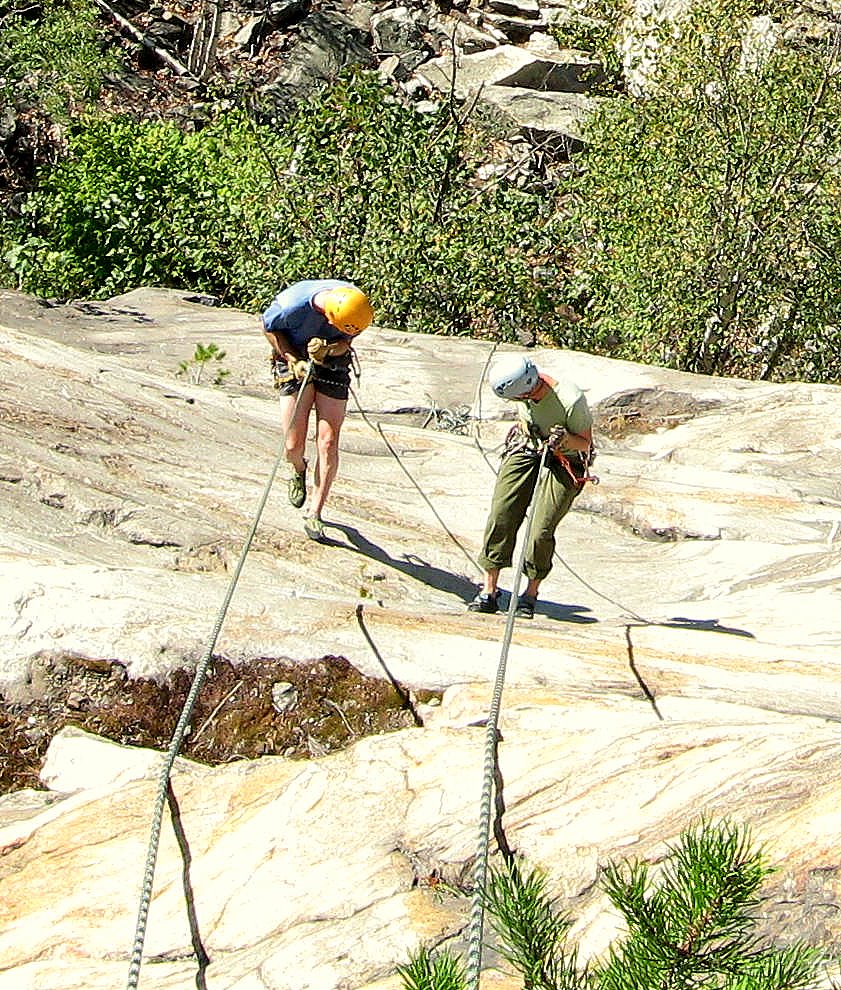4 reasons not to simul-rappel
Simul-rappelling is a technique in which two climbers rappel a single strand of the rope at the same time, counterweighting each other. While this is typically thought of as an advanced maneuver that you should only try when you really have to, such as an incoming lightning storm or on a very long multi pitch route, in some climbing circles it's being used as a more standard way to descend.
As you will discover below, I'm not much of a fan. However, there are a couple of situations when a simul-rappell might be a good idea.
If you need to rappel down some gully with loads of loose rock, a simul rap might be a good idea, because rocks that you kick down when you’re side-by-side won't nail anybody below. But, hopefully you don’t find yourself in a situation like this very often, as a standard rappel route should rarely be in dangerous areas like this.
Teaching a beginner to rappel - the more experienced person can descend right next to the beginner, and perhaps even be clipped to them loosely, to offer advice and encouragement.
image: http://theconspiracytimes.blogspot.com
If you and your partner are both solidly experienced with the technique, and observe a few common sense precautions such as:
knots in the end of the rope
using a third hand autoblock backup below your rappel device
being sure both strands of the rope reach the next rappel station
and possibly tethering yourselves together with a long sling
then simul-rapping it can be reasonably safe and possibly save you a little time.
But think about it: by the time you've added the knots in the end of the rope, the auto block back up, and tethering yourselves together with a sling, could you have already been down rappelling the normal way?
Or, as some people have described it, “being fast isn't particularly safe, and being safe is not particularly fast.”
Side note: If you want to improve your speed AND safety when rappelling, try pre-rigging your rappel on an extended sling. Both climbers rig at once, so they can check each other, and then the second can begin heading down the moment the first person is off rappel at the next anchor.
(One other tip, mentioned to me by a canyoneering expert: If you have to simul rappel with someone who is a relative beginner, you can put a carabiner block on their side of the anchor. That way, if they screw up and tension goes off the rope on their side, the block will catch in the anchor and you will not fall.)
However, there are some major downsides to simul-rappelling, both in terms of safety and speed.
IFMGA Certified Guide Rob Coppolillo, co-author of “The Mountain Guide Manual”, wrote the following article in Climbing magazine which summarizes the shortcomings. Below is a direct copy/paste, in italics.
(Note, not mentioned by Rob is the hopefully obvious downside of doubling the load on the rappel anchor. If it’s bolts, probably not an issue. If it's anything slightly sketchy, then potentially a big issue.)
Simul-rappelling without both climbers having a backup (third-hand) on their respective brake strands doubles the chances of a catastrophe. Should one climber lose control, the rope will feed through his rappel device and begin sliding through the anchor.
If one climber unweights his rappel, it introduces slack into the system and the rope will slip at the anchor, effectively dropping the other climber. If this occurs at an unlucky moment, or the rope begins to pull unchecked through the first climber’s device, it can result in a tragedy.
Less-experienced climbers typically rappel slower on a single-strand of rope because the relatively low friction of a single-strand rappel makes them nervous. They elect to simul-rappel, but then fail to make up any time because of the slower rappel.
While simul-rappelling, both climbers arrive at the next rappel station nearly simultaneously, which can be awkward (and slow). Typically, one rappeller waits up top while the other manages the anchor and/or transition. Having one climber prep the station speeds up the second climber going off rappel. Often it would be faster (and safer) to simply rappel in a traditional fashion.
Finally, if you want a few more good reasons not to do it, here's a quote from Canadian expert climber Will Gadd’s personal website:
“Don’t simul-rap and otherwise get tricky on your raps until you’ve really, really figured your systems out, and even then simul-rapping doesn’t generally speed things up much. If you are going to simul rap then have knots in the ends of the ropes, have some sort of prussic attaching the one climber to the other’s rope (so if one person loses control both don’t plummet, and if this idea doesn’t make sense then definitely don’t simul-rap), consider putting a blocking knot on the weak climber’s side (with a quick link so it doesn’t pull through), use auto-blocks on each climber, etc. I did a lot of simul-rapping over the years but have pretty much given up on it in the last decade, it’s open to problems unless so many control measures are put in that it becomes very slow. Very, very rarely is simul-rapping justified by expediency . . .”

